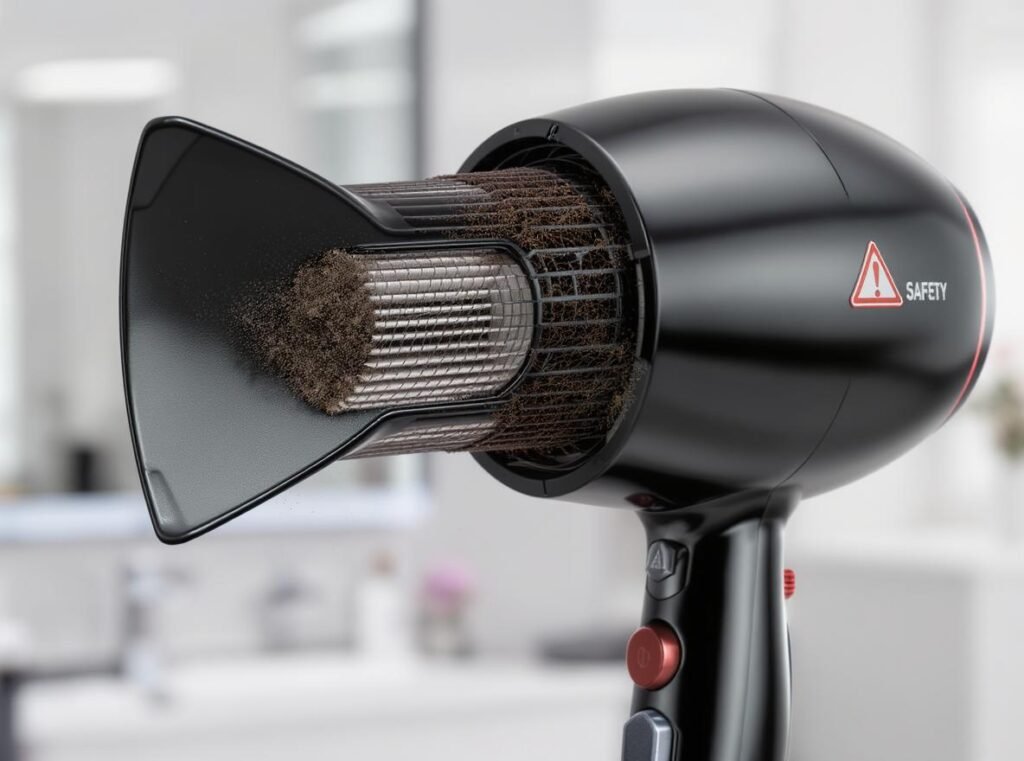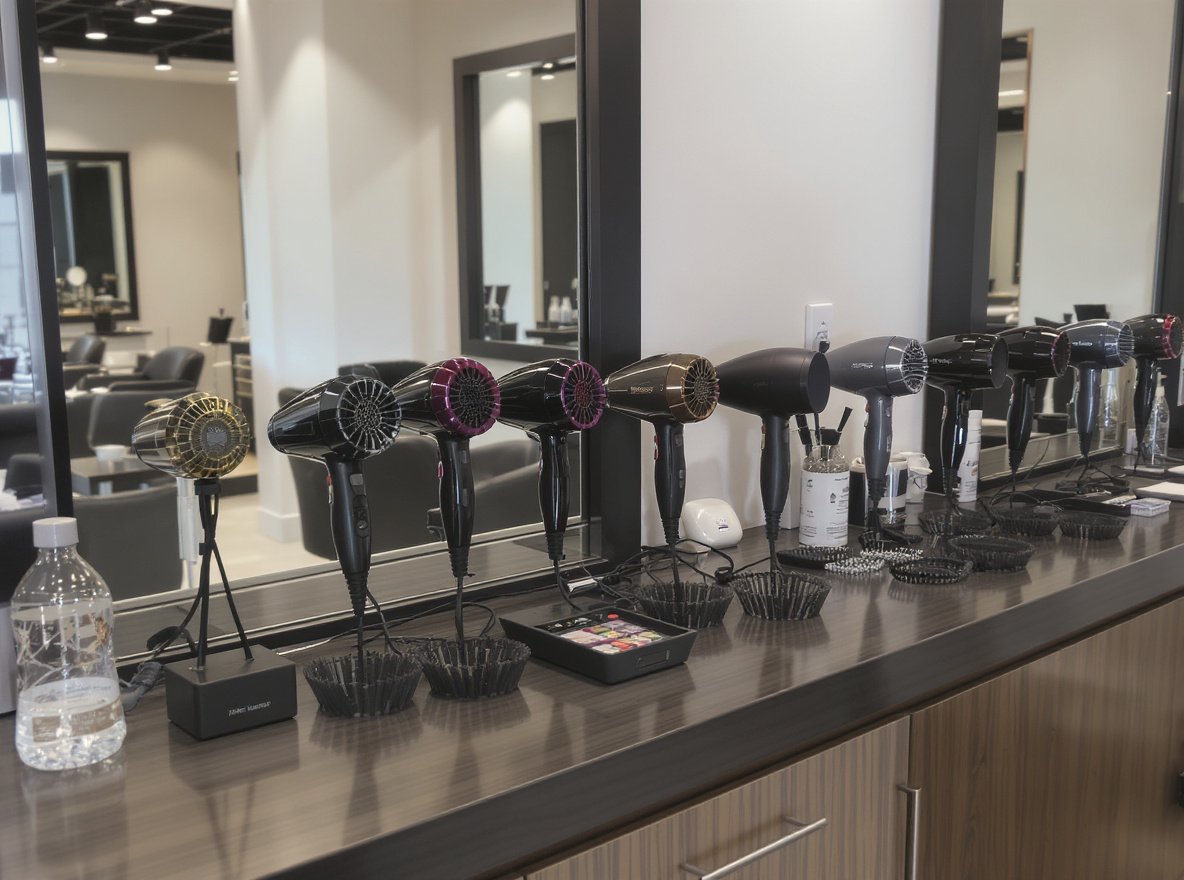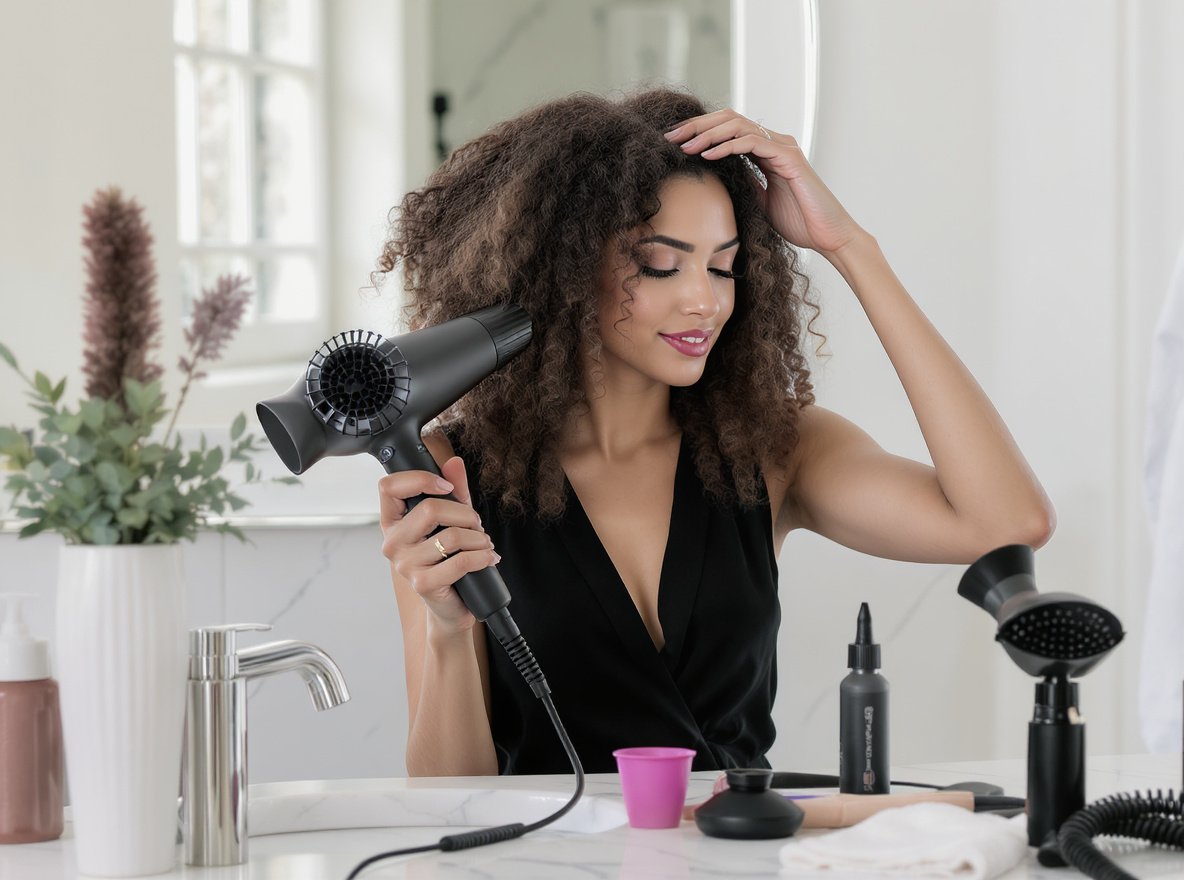Lint buildup on your hair dryer’s filter isn’t just unsightly—it’s a serious fire hazard. When hair dryers accumulate dust and debris, they overheat, consume more energy, and can even ignite, putting your business and clients at risk.
The safest way to remove lint from your hair dryer is to unplug the device, let it cool completely, remove the rear filter by twisting counterclockwise, and clean it with a soft toothbrush and warm soapy water. Always ensure the filter is completely dry before reinstalling to prevent electrical hazards.
Don’t let a clogged filter compromise your professional reputation or endanger your facility.
Table of Contents
ToggleWhy Does Lint Build Up in Hair Dryers?
Hair dryers naturally attract multiple types of debris due to their powerful airflow and heat generation. Understanding these sources helps you prevent excessive accumulation.
Hair dryers accumulate lint from fabric fibers, loose hair strands, dust particles, styling product residue, and pet hair that get pulled into the intake vent by the powerful internal fan. Heat and friction increase fiber breakdown, while electrostatic attraction helps particles stick to internal surfaces.
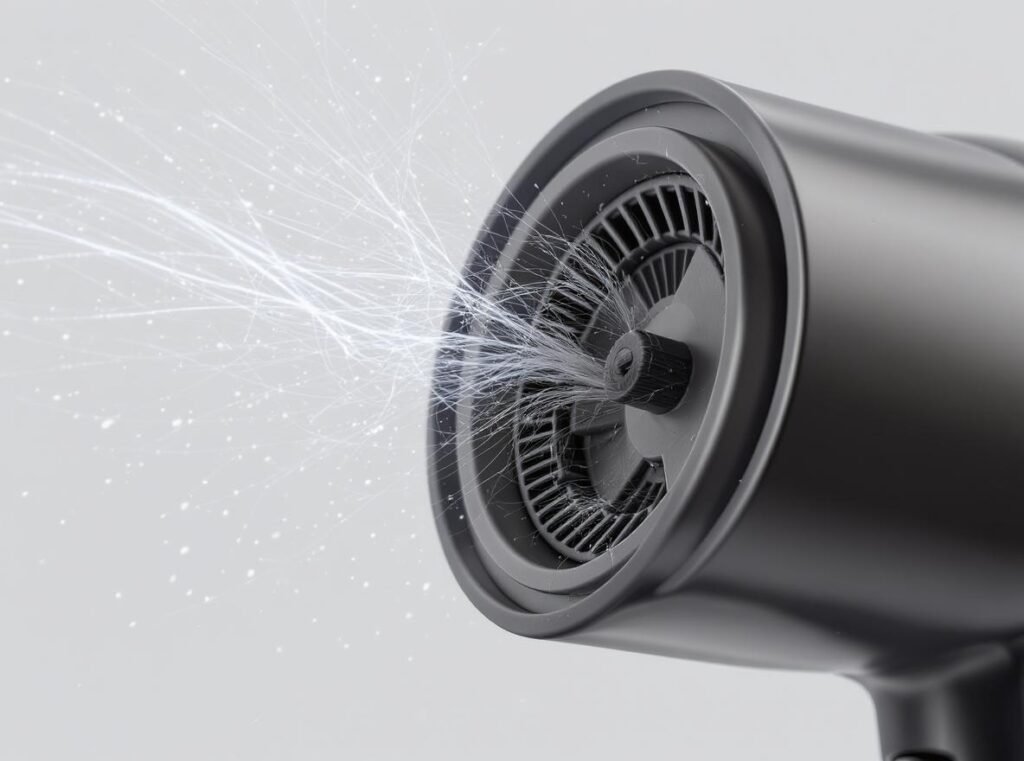
The problem compounds over time as restricted airflow creates increased suction pressure. This pulls in even more debris, creating a dangerous cycle that can lead to overheating and fire risk.
Primary contamination sources include:
• Fabric fibers from clothing that become airborne during styling sessions
• Hair particles that break away during the drying process
• Environmental dust from salon or home environments
• Product residue from hairsprays, gels, and styling treatments
• Pet hair in residential settings
Professional salons face additional challenges due to high-volume usage and multiple styling products being used simultaneously. The constant airflow combined with heat causes more particles to break free and accumulate in filters.
Electrostatic forces play a significant role in lint adhesion. As the dryer operates, static electricity builds up, attracting lightweight particles to internal surfaces where they gradually accumulate into thick, potentially flammable layers.
How Often Should You Clean Your Hair Dryer Filter?
Cleaning frequency depends on usage intensity and environmental conditions. Professional settings require more aggressive maintenance schedules than home use.
Professional salons should clean hair dryer filters daily with high-volume use, while busy home users need weekly cleaning. Average households require monthly maintenance, and light users can extend cleaning to every 2-3 months. Never wait until lint becomes visible—preventive maintenance prevents safety hazards.
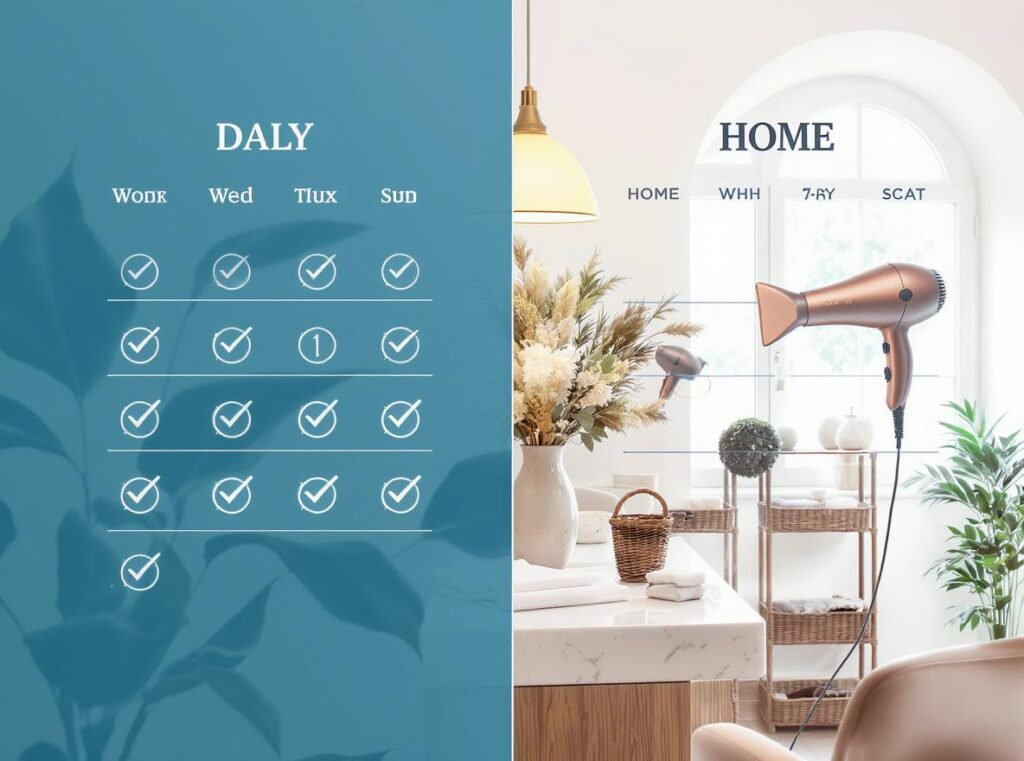
Leading manufacturers like Dyson recommend monthly cleaning for optimal performance, but real-world usage often demands more frequent attention.
Different environments require tailored maintenance schedules:
| Usage Level | Cleaning Schedule | Key Indicators |
|---|---|---|
| Professional salon | Daily | Constant use, multiple stylists |
| Heavy home use | Weekly | Daily personal use |
| Average household | Monthly | Regular family use |
| Light use | Every 2-3 months | Occasional styling |
Warning signs that demand immediate cleaning include reduced airflow, longer drying times, overheating, burning smells, or visible lint accumulation. These symptoms indicate your filter has reached dangerous clogging levels.
Professional stylists should incorporate filter inspection into their daily setup routine, checking for debris accumulation and cleaning when necessary. This prevents mid-session equipment failure and maintains consistent performance standards.
What Tools Do You Need to Clean Hair Dryer Lint?
Professional-grade cleaning requires specific tools to ensure thorough debris removal without damaging delicate components. Most supplies are common household items.
Essential tools include a soft-bristled toothbrush, cotton swabs, mild dish soap, warm water, and soft cloths. Optional equipment like compressed air, vacuum cleaners with brush attachments, and needle-nose pliers can enhance cleaning effectiveness for stubborn buildup.
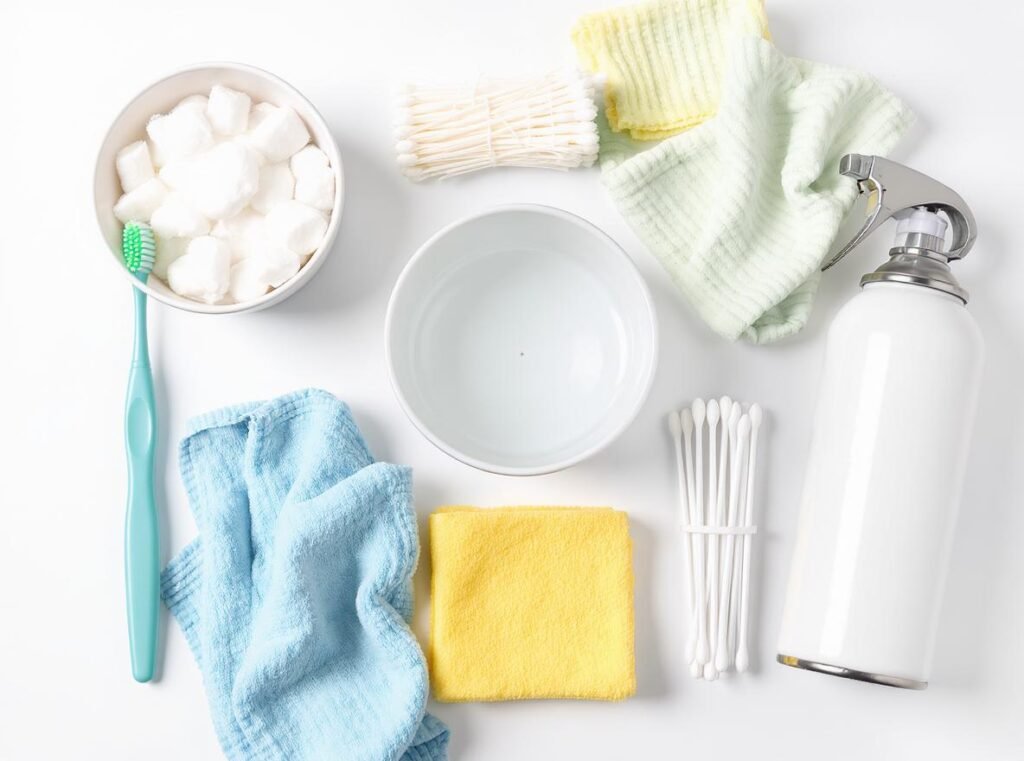
Quality tools make the difference between superficial cleaning and thorough maintenance that extends equipment life.
Basic Cleaning Kit:
• New toothbrush for gentle scrubbing without scratching
• Cotton swabs (8-10 pieces) for detailed cleaning
• Mild dish soap (pea-sized amount) for deep cleaning
• Warm water for rinsing removable filters
• Soft cloths or paper towels for drying
Professional Enhancement Tools:
• Compressed air cans for blowing out stubborn debris
• Vacuum with brush attachment for internal cleaning
• Needle-nose pliers for difficult filter removal
• Rubbing alcohol for exterior sanitization
• Small screwdriver for models requiring tool-based disassembly
Never use harsh chemicals, abrasive brushes, or excessive water pressure that could damage electrical components or void manufacturer warranties. The Laifex P1C features tool-free filter access, eliminating the need for specialized equipment.
How to Safely Remove the Hair Dryer Filter?
Safety protocols are non-negotiable when accessing hair dryer internal components. Proper procedures prevent electrical hazards and component damage.
Always unplug the hair dryer and allow complete cooling before filter removal. Most filters twist off counterclockwise, but some require gentle pressure or snap-off techniques. Work over a flat surface to catch loose components, and never force removal if resistance occurs.
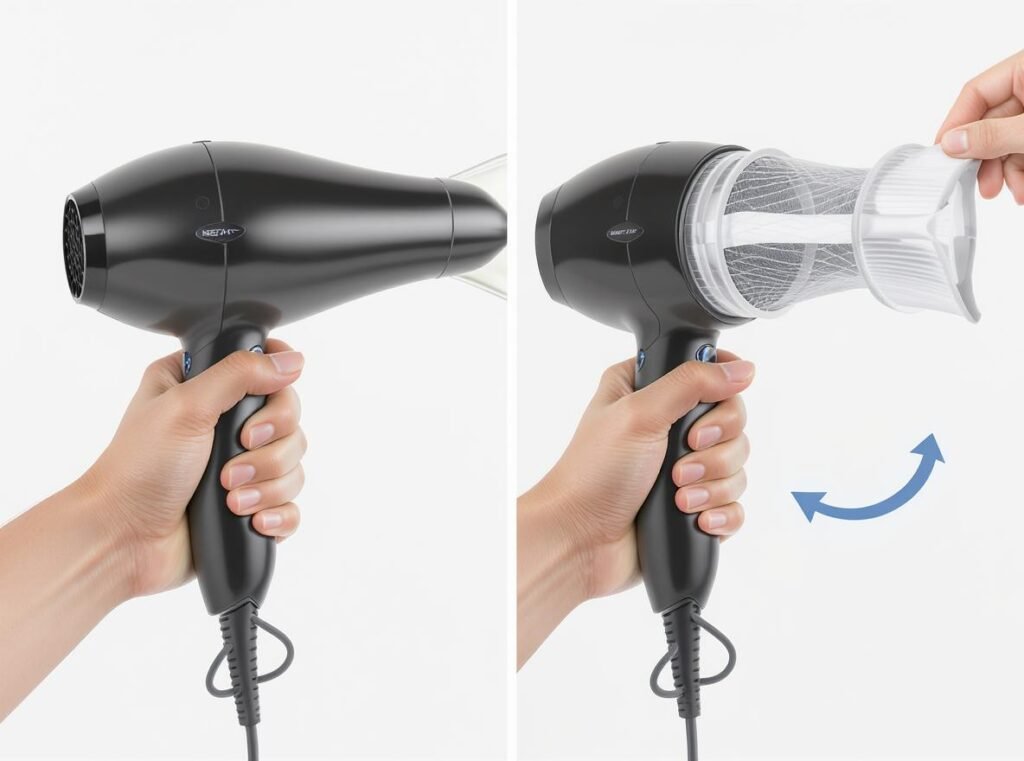
Electrical safety takes priority over convenience. Even brief contact with live components can cause serious injury or death.
Step-by-Step Removal Process:
- Unplug and cool – Disconnect power and wait 10-15 minutes minimum
- Identify filter type – Locate the rear intake filter design
- Test removal method – Try gentle counterclockwise rotation first
- Apply appropriate technique – Use snap-off or tool-based methods as needed
- Secure loose parts – Work over towels to catch screws or clips
Common Filter Types:
• Twist-off filters rotate counterclockwise until detached
• Snap-on filters require gentle downward pressure while pulling
• Hinged filters swing open rather than completely removing
• Clip-on filters have release tabs that must be pressed
If filters seem stuck, check for broken plastic tabs or hidden securing mechanisms. Some older professional models require tools for removal, but forcing stuck components can cause expensive damage.
What’s the Best Method to Clean Lint from Hair Dryer Filters?
Effective cleaning combines multiple techniques to ensure complete debris removal while preserving filter integrity. The approach varies based on contamination severity.
Begin with gentle dry brushing to remove loose debris, then rinse with warm water from inside to outside. For heavy buildup, soak in warm soapy water for 30 minutes, scrub with a soft toothbrush, and rinse thoroughly. Always ensure complete drying before reinstallation.
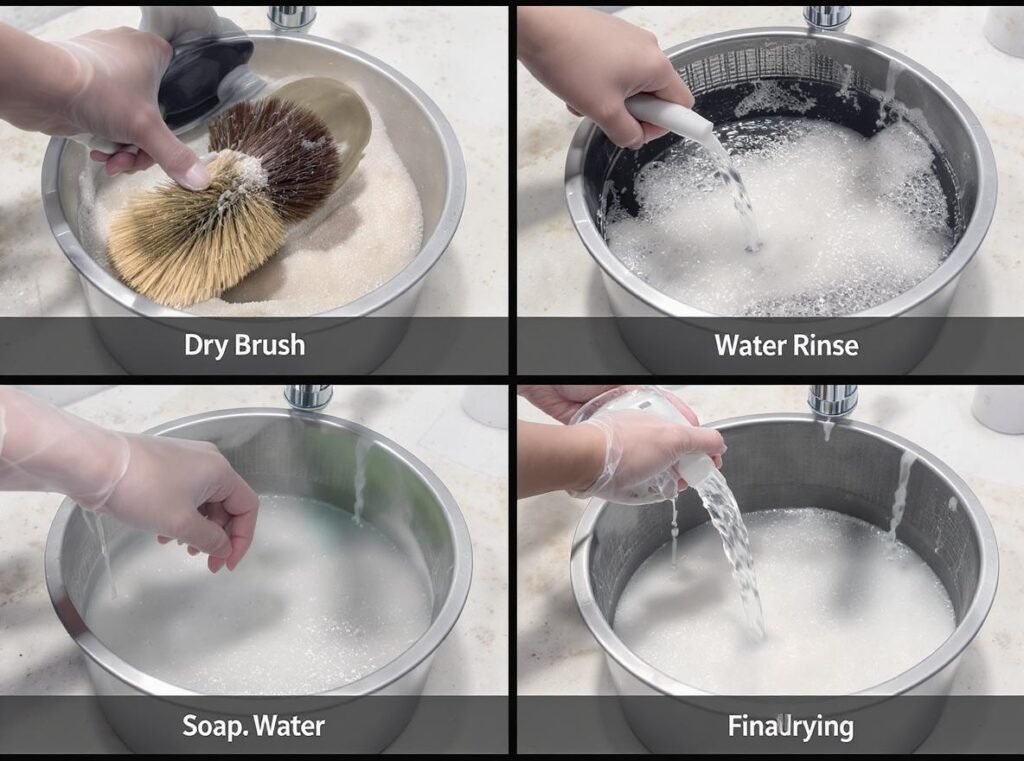
Professional-grade cleaning requires systematic approaches that address both visible and embedded debris.
Comprehensive Cleaning Process:
Stage 1: Preparation and Assessment
Tap the filter gently over a trash can to remove loose debris. Assess contamination level to determine cleaning intensity needed.
Stage 2: Dry Cleaning
Use a soft toothbrush with circular motions to dislodge embedded particles. Work systematically across the entire filter surface, paying attention to corners and crevices.
Stage 3: Water Cleaning
Run warm water through the filter from inside to outside, reversing normal airflow to flush out trapped particles. This technique mimics professional cleaning methods.
Stage 4: Deep Cleaning (Heavy Contamination)
• Soak in warm soapy water for 30 minutes
• Use clarifying shampoo or mild dish soap for stubborn residue
• Scrub gently with soft-bristled brush
• Rinse thoroughly to remove all soap residue
Stage 5: Drying and Verification
Squeeze gently with paper towels using pinching motions. Allow 24-hour air drying or until completely dry. Hold filter up to light to verify complete debris removal.
Can You Prevent Lint Buildup in Hair Dryers?
While complete prevention is impossible, strategic approaches can significantly reduce accumulation rates and extend maintenance intervals.
Regular cleaning schedules, proper storage in clean environments, room ventilation during use, and quality equipment selection can reduce lint buildup by up to 70%. Professional-grade models like the Laifex P1C feature advanced filtration systems that resist clogging better than consumer alternatives.

Prevention strategies save time, money, and reduce fire risks in professional environments.
Environmental Controls:
• Clean storage areas using protective covers or clean drawers
• Proper ventilation to reduce airborne particles during operation
• Air purifiers in styling areas to minimize ambient dust
• Regular room cleaning to reduce environmental contamination sources
Usage Techniques:
• Appropriate heat settings to minimize fiber breakdown
• Maintain proper distance from hair to reduce strand intake
• Clean hair first to remove loose strands and product buildup
• Avoid over-drying which increases static and particle attraction
Equipment Selection:
Professional-grade dryers like the Laifex P1C incorporate advanced filtration technology that resists clogging while maintaining powerful airflow. The investment in quality equipment pays dividends through reduced maintenance costs and improved reliability.
Minimize aerosol use near operating dryers, as these products contribute to sticky residue that traps additional particles. Professional salons should establish clear protocols for product application timing and ventilation management.
What Happens If You Don’t Clean Hair Dryer Lint?
Neglecting hair dryer maintenance creates serious safety hazards and performance issues that can devastate professional operations and endanger lives.
Clogged filters cause overheating, fire risks, reduced airflow, increased energy consumption, motor strain, and potential electrical hazards. Professional environments face additional risks including liability issues, insurance claims, and regulatory violations that can permanently damage business reputation.
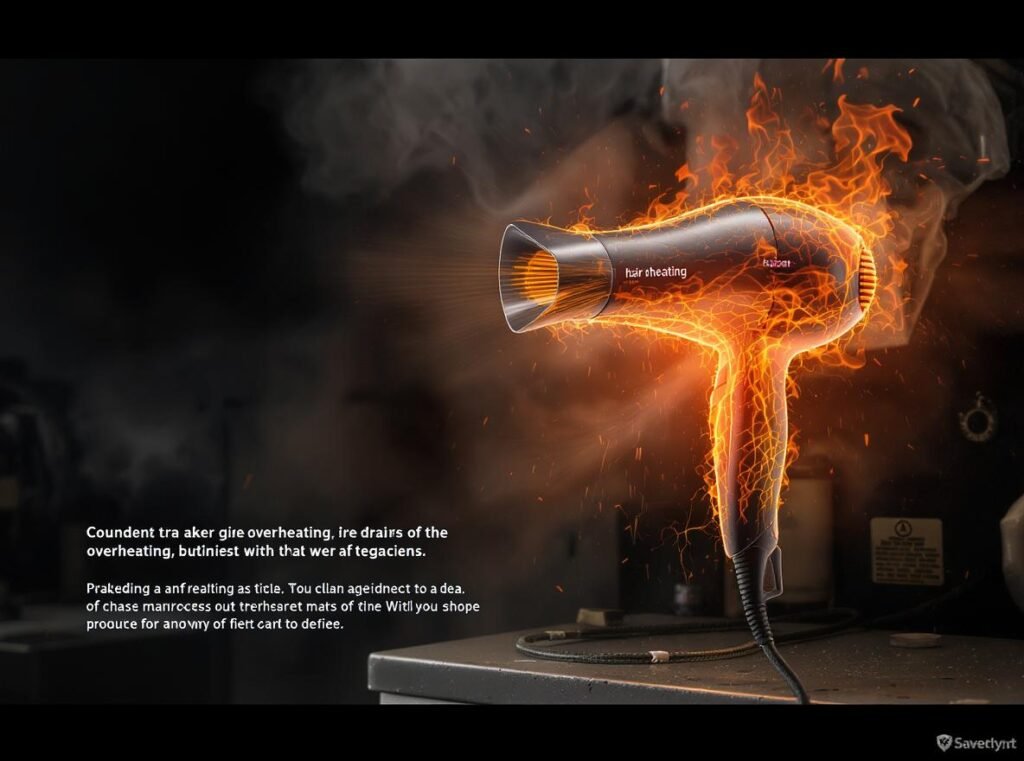
The consequences escalate progressively, making early intervention critical for safety and business continuity.
Safety Hazards:
• Fire risk – Lint is highly flammable and can ignite from overheating
• Overheating damage leading to burns or equipment failure
• Electrical hazards from components working beyond design limits
• Carbon monoxide risk in gas-powered professional units
Performance Degradation:
• Reduced airflow requiring longer styling times
• Inconsistent heating affecting service quality
• Increased energy costs from inefficient operation
• Motor strain leading to premature replacement needs
Health and Business Impacts:
• Poor air quality from releasing particles into salon environments
• Bacterial and fungal growth in moist, clogged conditions
• Client allergic reactions from airborne contaminants
• Professional liability from safety incidents
For wholesale buyers, equipment failure during peak business hours means lost revenue, client dissatisfaction, and potential safety violations. A professional-grade dryer like the Laifex P1C costs significantly less than the liability and replacement costs associated with neglected maintenance.
Are There Professional Hair Dryer Cleaning Services?
Professional cleaning services exist for high-end salon equipment, but most filter maintenance is more cost-effective to perform in-house with proper training and tools.
Professional services are available through manufacturer repair centers, salon cleaning companies, and specialized repair shops. These services make sense for high-value equipment, persistent performance issues, or bulk maintenance contracts, but routine filter cleaning is typically more economical to handle internally.
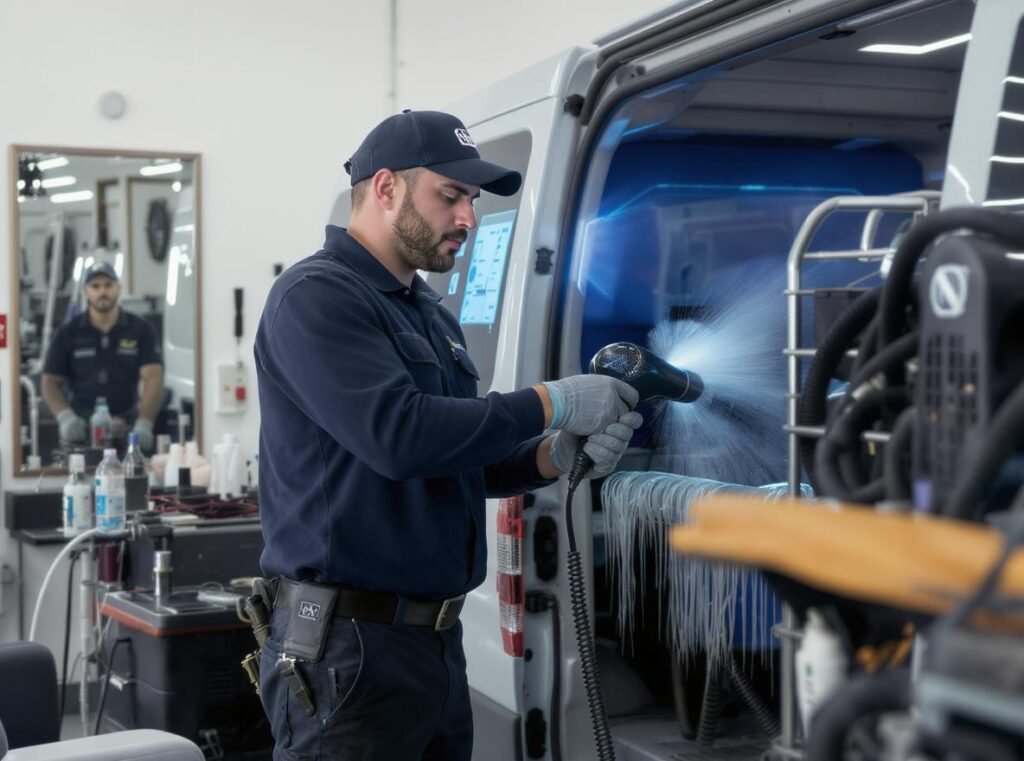
Understanding when to use professional services versus in-house maintenance helps optimize operational costs.
Professional Service Options:
• Manufacturer repair services like Parlux offer comprehensive cleaning and maintenance
• Salon cleaning companies include equipment cleaning in facility maintenance contracts
• Specialized repair shops provide deep cleaning and component replacement
• Mobile service technicians for high-volume commercial operations
Professional Services Include:
• Complete disassembly and internal component cleaning
• Filter replacement when cleaning cannot restore function
• Motor maintenance and lubrication services
• Safety inspections and electrical testing
• Performance optimization and calibration
When Professional Services Make Sense:
• High-value equipment requiring specialized knowledge
• Persistent performance issues after proper home cleaning
• Warranty compliance for commercial equipment
• Bulk maintenance contracts for large salon chains
For most applications, staff training on proper maintenance procedures provides better value than outsourcing. The Laifex P1C includes comprehensive maintenance instructions that eliminate the need for professional cleaning services for routine filter care.
How Do You Know When to Replace Hair Dryer Filters?
Filters eventually reach the end of their useful life despite proper maintenance. Recognizing replacement indicators prevents performance issues and safety hazards.
Replace hair dryer filters when they show physical damage like cracks, permanent discoloration, warped shapes, or persistent odors. Most professional filters last 6-12 months with proper maintenance, while consumer-grade filters typically need replacement every 3-6 months depending on usage intensity.
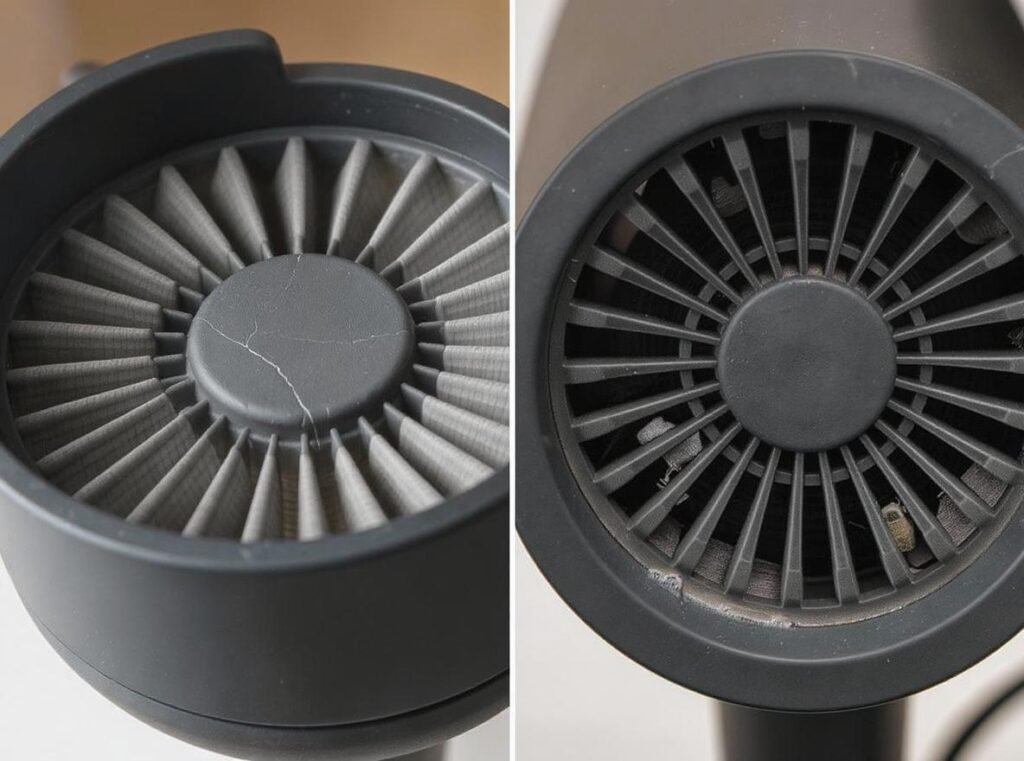
Replacement timing depends on usage patterns, environmental conditions, and filter quality.
Definitive Replacement Indicators:
• Physical damage – cracks, holes, or broken mounting components
• Permanent staining that doesn’t respond to cleaning
• Warped or misshapen filters that don’t fit properly
• Persistent odors even after thorough cleaning
• Reduced effectiveness despite proper maintenance
Lifespan Factors:
• Usage frequency – daily professional use shortens filter life significantly
• Environmental conditions – dusty or humid environments accelerate wear
• Maintenance quality – proper cleaning extends operational life
• Filter construction – professional-grade materials last longer
Replacement Sources:
• Manufacturer websites often stock replacement filters
• Professional beauty supply stores carry common filter types
• Authorized repair centers source hard-to-find components
• Universal filters may work for discontinued models
When ordering replacements, always specify exact model numbers to ensure proper fit and performance. Generic alternatives may not meet safety standards or could void equipment warranties.
Professional-grade equipment like the Laifex P1C uses durable filter materials that resist damage and provide extended service life, reducing replacement frequency and operational costs for busy salons.
Summary
Regular lint removal is critical for hair dryer safety, performance, and equipment longevity. Clean filters daily for professional use or monthly for home applications using soft brushes and warm soapy water. Prevention through proper storage and quality equipment reduces maintenance needs while protecting your investment and ensuring client safety.
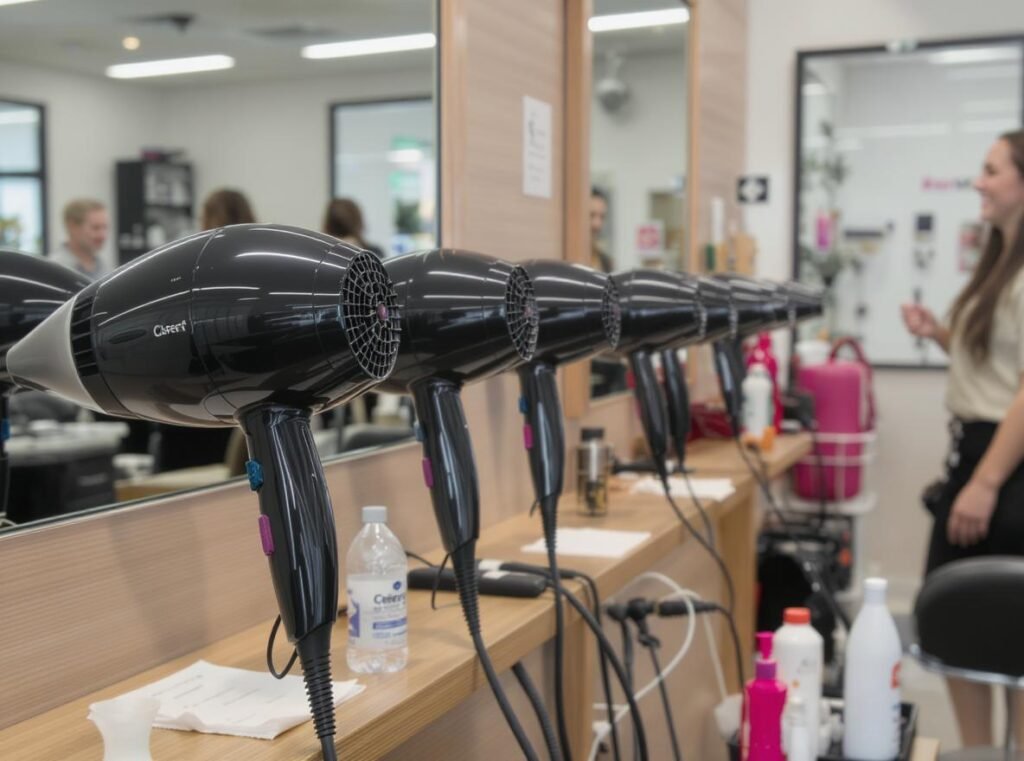
Ready to upgrade to professional-grade equipment that’s designed for easy maintenance? Explore the Laifex P1C high-speed hair dryer with advanced filtration technology at https://laifex.com/p1c-hair-dryer/ or contact us for wholesale pricing and bulk orders that keep your business running safely and efficiently.

